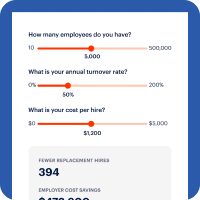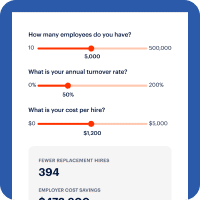The following article is another in our series that examines average employee turnover rates by industry. In this article, we look at the call center industry to see what might be affecting employee turnover rates and retention rates as well as why employees aren’t sticking around.
According to a 2022 NICE WEM Global Survey that polled 400 agents and managers at call centers across the U.S. and U.K., the average attrition rate for call centers in 2021 was 42%. High turnover and abbreviated tenure at contact centers means high costs for recruiting and training, lost employee productivity and diminished morale in the workplace. Discover what contributes to high turnover and what specific steps can be taken to improve the metrics.
Turnover Rates by Profile
According to a 2022 Cresta Insights Report, employee attrition at customer call centers that focus on customer care and support is extremely high—about 1.3X the average annual attrition rate in the U.S. Take a look at the attrition rate in contact centers since the start of COVID-19:
- All: 83.7%
- Sales: 79.8%
- Care/Support: 87.6%
The Cost of Employee Turnover
The cost of employee turnover in call centers is the sum of many factors, including finding, interviewing, training and onboarding new employees. The same research shows the average tenure of call center employees as:
- All: 14.3 months
- Sales: 15 months
- Care/Support: 13.7 months
Additional research by Harvard Business Review researcher Keith Ferrazzi and reported by Sharpen CX suggests it costs between $10,000–$20,000 to replace a call center agent, meaning the annual average attrition costs for U.S. call centers is significant.
According to Cresta, the annual costs to backfill a call center of a 100 agents are averaged as:
- All: $800,000–$1.7 million
- Sales: $800,000–$1.6 million
- Care/Support: $900,000–$1.8 million
What Contributes to Turnover in the Call Center Industry
The list of reasons attributed to agent turnover is long, which is why many contact center operators believe that turnover is a necessary evil of the industry. However, there are solutions for these high turnover rates, and to identify solutions, one must first pinpoint the root causes of turnover:
- Non-challenging or repetitive work
- Lack of recognition
- No career growth or development opportunities
- Inflexible working environment
- Employee disengagement
- Excessive pressure or stress
- Abusive calls
- Low job satisfaction
Additionally, low pay plays a role in high turnover rates at contact centers. As many contact centers staff a majority of minimum wage roles, keeping up with competitors like Amazon, who hire employees with a similar skillset, is increasingly difficult considering the tech giant continues to increase their wages.
How to Curb Turnover at Contact Centers
High turnover rates have a multitude of negative effects on an organization. Specifically, contact centers with high turnover also experience:
- A loss of knowledge, expertise and productivity
- A drop in morale among remaining employees
- A perception that something is fundamentally amiss at your business
- High costs associated with recruiting, hiring and training of new staff
Combining the root cause with the result of turnover helps to generate innovative ideas for curbing turnover as a contact center employer.
Break up the monotony of the job
To boost engagement in employees who feel their job is non-challenging or repetitive, blend tasks so your agents aren’t only operating via telephone:
- Consider email campaigns
- Certify agents to support customers or even interact on behalf of your brand via social media
- Give agents administrative tasks like application processing, faxing or office paperwork
- Find ways to connect your agents to customers before a problem arises, like during a welcome call
By adding diversity to your agent’s jobs, you can help counteract boredom.
Provide training and development options
According to a 2021 CCW Digital Survey, some reasons employees cite for leaving a contact center are:
- Emotional disconnection from the team and brand
- Not enough recognition or rewards
- Lack of empowerment
- Lack of transparent performance reviews
Training and development can help associates see a clear career path of progression within your organization, which can incentivize them to stick around longer and grow with your company. If a clear career path is not an option, enhanced training programs are still valuable for contact center agents to succeed and feel more engaged in their role.
Many contact center agents are forced into learning the role while on the job. This can cause undue stress while fielding escalated calls. When employees must provide difficult answers without appropriate information and training resources, it can push employees toward disengagement at a faster rate than those who feel prepared to handle emotional customer calls.
Promote well-being
Researchers in Italy found that promoting the well-being of call center employees is an important key to fostering job satisfaction and reducing turnover.
In their study, the researchers focused on training programs that dealt with emotional dissonance. For example, when a customer calls into a contact center, it’s likely they are calling with:
- A problem
- An expectation about the quality of service
- An assumption the call will be handled quickly
If for any reason service dips below the expectations, emotions like negativity, aggression, anger and frustration can occur. Subsequently, these emotions are pushed on to your agents, which can create a stressful work environment that sometimes bleeds into personal life.
By nature of the job, contact agents mask their natural emotions in the name of customer service, which can create emotional dissonance. As the researchers found, emotional dissonance has a direct correlation to job satisfaction and turnover rates.
Organizations who focus on training or benefits directed toward employee well-being, can improve employee engagement, productivity and decrease turnover.
Zero in on absenteeism
Absenteeism can be a precursor to turnover. In organizations with high rates of absenteeism, turnover can happen in two forms:
- The absent worker is disengaged and will eventually find a new job
- Those who bear the brunt of the work to cover for absent employees will become overworked, burnt out and eventually leave
In either scenario, the customer experience worsens, workplace morale drops and overworked staff will become disengaged. By focusing on the factors that influence absence, you can help lower rates of absenteeism at your contact center. The following are commonly cited reasons for employee absenteeism:
- Low morale
- Burnout
- Lack of schedule flexibility
- Disengagement
- Lack of support
One way to discourage absenteeism could be to offer rewards or incentives to those who practice responsible work habits. For example, organizations can consider offering increased paid time off or schedule flexibility to help accommodate unavoidable absenteeism.
Additionally, offering an on-demand pay benefit can encourage workers to come to work, as they can cash out after their shift. Our research has shown that offering DailyPay translates into re-engagement and increased productivity:
- The average tenure of employees who used DailyPay increased by 27% over non-DailyPay users
- In the year ending March 2022, DailyPay enrollee turnover was 30.69% lower than non-DailyPay enrollee turnover
- 52% of users say their opinion of their employer has improved since they began using DailyPay
- 48% of users say they are more motivated to remain with their current employer because they offer DailyPay
Giving your employees a reason to come to work and stay engaged is the key to improving your retention rates.
Want to learn more about how DailyPay is curbing turnover costs for contact centers?













